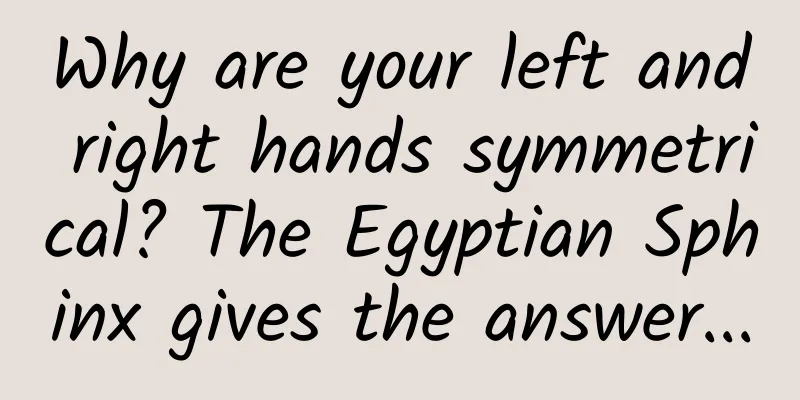Why are your left and right hands symmetrical? The Egyptian Sphinx gives the answer...

|
Why life prefers a certain chirality is a profound scientific question that has long attracted scientists from various disciplines such as biochemistry, cell biology, and evolutionary biology to explore. Recently, a team led by Professor Greg Huber, a biophysicist at the Chan Zuckerberg Biocenter in San Francisco, has come up with a very interesting solution: using the image of the ancient Egyptian sphinx "mythical beast" to establish the "Sphinx Theory" to try to explain the mystery of the chirality preference of organisms in a limited space. The research paper was published in Physical Review Research (PRR). Written by | Xiaoye On the cliffs of Thebes, on the far bank of the Nile, there is a monster called the Sphinx (also known as the Lion-faced Beast) guarding the only way into the city. It would stop passers-by and ask a riddle: What animal walks on four legs in the morning, two legs at noon, and three legs at night? The Sphinx riddle is well-known to everyone, allowing us to think about and understand human beings from a philosophical perspective: who are we, where do we come from, how did life begin... Recently, modern scientists have created an interesting "Sphinxology", which uses ancient images to unfold and try to solve the most basic and important mystery of biology from a natural science perspective: chirality preference. Chirality is everywhere When we spread our palms, our left and right hands are mirror images of each other, but no matter how each hand rotates, it cannot be completely superimposed, so a single hand itself is not symmetrical, which is the most intuitive manifestation of the "handedness" phenomenon. People have left and right hands, and based on this, asymmetric chirality structures can also be divided into left-handedness (L type) and right-handedness (D type). Chirality is everywhere in nature, from microscopic molecules to organisms visible to the naked eye. For example, the vast majority of DNA helical structures have right-handed helical structures, and the vast majority of organic molecules that make up life are chiral molecules. Amino acids and natural sugars have left and right chirality. In the macroscopic world, taking humans as an example, there is also obvious asymmetry on these two body axes, from head to toe and from front to back: for humans with normal development, the position of the main organs will always be biased to one side of the body axis, the liver is biased to the right, the stomach is always on the left, and the heart is slightly biased to the left, etc. In addition, the structure of the organs themselves is also asymmetrical. Only when something goes wrong in the development process of the human body will there be abnormal left-right symmetry or a complete reversal of the left and right positions. Although chirality is clearly left-handed, scientists have discovered another peculiar phenomenon at the microscopic molecular level: homochirality, which means that a certain chiral configuration accounts for the majority of the same type of molecules that make up life. For example, the a-amino acids that make up proteins are almost all L-type, and the ribose in ribonucleic acid (RNA) and deoxyribonucleic acid (DNA) is all D-type. Almost all organisms, without exception, choose left-handed amino acids and right-handed sugars during synthesis and metabolism. From the DNA helix structure (left), the amino acids that make up proteins (middle) to RNA and D-ribose in DNA (right), all show obvious chirality preferences | Image source: pixabay, wikipedia This raises an important question about homochirality: Why does life prefer one chirality over another? Different scientists have tried to answer this question from different perspectives, including biochemistry, cell biology, evolutionary biology, etc. But recently, a team led by Professor Greg Huber (Chinese name: Hu Boguang), a biophysicist at the Chan Zuckerberg Biohub in San Francisco, came up with a very interesting solution: using the image of the ancient Egyptian sphinx as a "mythical beast", they established the "Sphinx Theory" to try to explain the mystery of chirality preference in organisms within a limited space. The research paper was published in Physical Review Research (PRR) [1] (see figure below). The Origin of the Sphinx Theory In 2018, Professor Hu formed his own biophysics theory research group in San Francisco, introduced theoretical physics tools, and created complex biological process models for research. But the specific research object was born earlier. As early as when Professor Hu was the deputy director of the Kavli Institute for Theoretical Physics (KITP) at the University of California, Santa Barbara, he noticed the chiral characteristics of the sphinx geometric image. Although it has not been paid attention to by the academic community for a long time, he believes that if this ancient geometric image is used for tiling problems, it may reveal the problem of chiral preference in biology. Real sphinx statue and sphinx geometric figures | Source: danielharper.org In fact, the connection between geometry and biology has been discovered by scientists since the middle of the last century, especially in the field of virology. In 1956, James Watson and Francis Crick of Cambridge University (who later became Nobel Prize winners in 1962 for establishing the DNA double helix structure model) predicted [2] that isohedral virus particles should have identical subunits arranged in a cubic symmetric manner. In the 1960s, structural biologist Donald Caspar and biophysicist Aaron Klug used a geometric framework to classify viruses in viral capsids [3]. They were inspired by the geodesic dome designed by the famous architect R. Buckminster Fuller, and described the beautiful physical geometry theory of the arrangement of protein molecules in viral capsids in their article "Physical principles in the construction of regular viruses" [4]. Intent on combining geometry with chirality, Huber discussed the idea with his friend Professor Robert Ziff at the University of Michigan. Ziff then brought in colleagues Craig Knecht and Walter Trump, who were also very interested in the Sphinx research topic. Gregory Huber The four of them hit it off and the research team was established. Starting from the end of 2018, the team began to explore the chirality issue step by step, starting with the tessellation of two-dimensional images of the sphinx. Although the global COVID-19 pandemic in 2019 also affected the team and the pace of research was once slowed down, hard work pays off. After nearly five years of dedicated research, Huber's team's "Sphinx Theory" was finally published. The ever-changing sphinx paving Specifically, the team started with the most basic triangular geometric image and used six equilateral triangles to piece together the smallest two-dimensional image of the Sphinx (see the figure below), also known as the 1st-order Sphinx, which exhibits inherent chirality: the head facing left is left-handed (L-Sphinx), and the head facing right is right-handed (R-Sphinx). Left-handedness | Source: Reference [1] Next, four 1-order sphinxes can be paved into a 2-order sphinx, and nine 1-order sphinxes can be paved into a 3-order sphinx. And so on, an n-order sphinx is paved with nxn 1-order sphinxes. The upper left corner of the above picture shows a 1st-order sphinx, the lower left corner shows a 2nd-order sphinx, and the middle and right sides show four 3rd-order sphinxes. | Image source: Reference [1] Since the 1st-order Sphinx is an asymmetrical shape, there are many possible combinations of several 1st-order Sphinx tilings. For example, two 1st-order Sphinxes can be paired in 46 or 47 different ways, while simple symmetrical shapes such as squares can only be combined in one way. Higher-order Sphinxes, such as the 3rd-order Sphinx tiling shown above, have 4 different combinations. As the number of 1st-order Sphinxes increases during the paving process, the possible combinations also grow exponentially: there are 153 different combinations of 5th-order Sphinxes, nearly 72,000 combinations of 6th-order Sphinxes, and an astonishing 10^30 combinations of 13th-order Sphinxes, growing exponentially. 153 collage combinations of the 5-level Sphinx | Image source: Reference [1] In addition to tiling higher-order sphinxes, the 1st-order sphinx can also tiling other symmetrical or asymmetrical polygons in various combinations. Based on such polygons (including the sphinx), the researchers developed a Monte Carlo calculation method to generate new tiling patterns from given tiling patterns, making it easier to start from larger and more complex patterns, combining chiral energy and graphic frameworks to explore their chiral characteristics. Chirality Preference in the World Looking back at the history of science, research on the mysterious chirality problem has been going on for more than 100 years, dating back to 1848, when French chemist Louis Pasteur first proposed the concept of molecular chirality by separating mirror-image crystals of tartrate. Interestingly, Lewis Carroll, a mathematics lecturer at the University of Oxford in the UK, also described the mysterious chirality phenomenon through the mirror in his two books, Alice's Adventures in Wonderland (1865) and Alice Through the Looking Glass (1871). In the early 20th century, British mathematical physicist Baron Kelvin formally coined the term "chirality"[5]. However, it was not until the 1950s, especially in 1953, a year of great success in feasibility studies on the origin of life, that F.C. Frank of the H.H. Wills Physics Laboratory at the University of Bristol in the UK proposed a mathematical model for the evolution of homochirality[6]. This theoretical research attracted several generations of chemists and was experimentally verified more than 40 years later[7]. Also in the 1950s, the problem of homochirality made a major breakthrough in the field of physics. In 1956, theoretical physicists Tsung-Dao Lee and Chen-Ning Yang raised the question of whether there is homochirality in weak interactions, that is, whether parity is conserved in weak interactions. Subsequently, Tsung-Dao Lee contacted Chien-Shiung Wu, an expert in β decay and an experimental physicist, and they discussed many possible experimental verification schemes. According to Chien-Shiung Wu's later memoirs, she thought that although this was a challenge, it was also a "golden opportunity". She proposed an experiment using 60Co to test whether parity is conserved in β decay[8], and cooperated with the low-temperature research group of the National Bureau of Standards of the United States[9], and finally proved that parity is not conserved in weak interactions (Tsung-Dao Lee and Chen-Ning Yang later won the 1957 Nobel Prize in Physics for this. Although Chien-Shiung Wu missed the Nobel Prize, she won the first Wolf Prize in Physics in 1978). For more than a century, from microscopic particles to biological molecules, the problem of homochirality has always attracted scientists from various fields to challenge it. In an interview with Fanpu, Professor Huber said that he always believed that the universe should not favor one chirality. As the scale expands, the chirality preference gradually emerges, and chirality may be very mysterious. After Huber's team carefully studied the ever-changing tiling methods of the Sphinx, the next step was to associate it with chirality. In order to more intuitively present the chirality distribution of local areas within the tiling pattern, the team set the L-Sphinx to blue and the R-Sphinx to red. Taking the 7th-order Sphinx as an example, all possible tiling methods were overlapped, and it was unexpectedly discovered that the shape of the pattern boundary is related to the left (or right) chirality preference: Image source: References [1] As shown in the picture above, in the 7-order Sphinx, different areas at the corners are obviously bluer or redder, and this pattern can also be seen in the symmetrical figures formed by the dense paving of the Sphinx, such as the 12-order diamond figure shown in the figure below. Image source: References [1] Subsequently, the researchers introduced chiral interaction energy to simulate high and low energy, similar to the interaction of chiral sphinxes under high and low temperature conditions. When two 1-order sphinxes of the same chirality are collaged together, it is considered to be low interaction energy, while when two sphinxes of opposite chirality are collaged together, it is considered to be high interaction energy. The researchers therefore hypothesized that, considering the influence of the above-mentioned graphic boundary on chirality preference, the system at a lower temperature (n-order sphinx) will exhibit a unique chiral phase or a phase in which one chirality occupies most of the image. Through the Monte Carlo algorithm, taking the 23rd-order L-sphinx as an example (see the figure below), it was found that under high temperature conditions, the 1st-order sphinxes of the same chirality can hardly interact with each other, and the left and right chirality fit together randomly. The higher the interaction energy, the easier it is to form an image with chaotic distribution of left and right chirality (the sphinx on the right). As the temperature decreases, more 1st-order L-sphinxes fit together, occupying most of the positions in the image, the interaction becomes more orderly, and the interaction energy is also low, so that more identical chirality is collaged together, forming a final image with left-handedness as the main chirality preference (the sphinx on the left). Image source: References [1] Moreover, the researchers expect that as the size of the system increases, the chirality may change dramatically, which is also a future research topic for the team. After all, the study provides a simplified basic chirality model, indicating that order can be generated from chaos, and similar chiral molecules will be more attracted to molecules similar to themselves. In this sense, the sphinx geometry model proposed by Professor Huber's team provides a starting point for solving the mystery of chirality. Huber also revealed to Fanpu that in addition to the results of the paper published in Physical Review Research, his team has many other discoveries based on the Sphinx Theory, but they have not yet been officially published. For example, the thermodynamics of Sphinx tiling, the phenomena that occur when the tiling boundary fluctuates, etc. With the publication of more results in the future, the content of the Sphinx Theory will become richer and richer. Any law discovered from it will help promote progress in many scientific fields, such as the structure of virus capsids, or how magnetism triggers chain reactions, and may eventually solve the mystery of homochirality of life molecules. In October this year, Huber's team "moved" to the University of California San Francisco, and the "Sphinx" continued its legend in the field of science in the 21st century... We would like to thank Professor Greg Huber for his tireless guidance and comments on this article.
1. Go to the "Featured Column" at the bottom of the menu of the "Fanpu" WeChat public account to read a series of popular science articles on different topics. 2. Fanpu provides a function to search articles by month. Follow the official account and reply with the four-digit year + month, such as "1903", to get the article index for March 2019, and so on. Copyright statement: Personal forwarding is welcome. Any form of media or organization is not allowed to reprint or excerpt without authorization. For reprint authorization, please contact the backstage of the "Fanpu" WeChat public account. |
<<: Yuncheng Salt Lake: A colorful "palette" that never fades for billions of years
Recommend
How does a brand use TikTok? The official finally gave the answer for the first time today!
I guess only blockchain conferences can be this p...
A gamma-ray burst that occurs once in a thousand years! But does it bring more cosmic mysteries?
In a disk galaxy 2.4 billion light-years away fro...
Many institutions in many places have launched the "Yangkang" physical examination package. Is it necessary to do such a physical examination?
Recently, patients infected with the new coronavi...
Hot marketing promotion calendar for the second half of 2019!
After a busy June The second half of 2019 Also ca...
Will the moon fall? What is the probability? What would happen if it really falls?
Will the moon fall? If someone asks this question...
Google announced six new features for Android: earthquake warning, star information, etc., to be launched this summer
[[405895]] June 16 news Google announced some of ...
Tips for building B2B user portraits!
Let me share an approach to B2B user profiling . ...
Recommended flower-viewing routes along the Central Axis, including flower-viewing guides for 111 Beijing parks!
The Qingming Festival holiday is coming soon. Hav...
How much does it cost to be an agent of Haixi Animation Mini Program?
How much does it cost to be an agent of an animat...
From 0 to 1, play with short video promotion and operation on Tik Tok!
Today we will share the following 5 major section...
Car companies increase investment in local markets, forecast says China's luxury car market is expected to become the world's largest this year
In the past two years, the series of "rebell...
"How to get more than 10,000 followers in 15 days" Short video account follower growth course
Course Contents: 1. How to create a profitable ac...
Shh! This is the secret of astronauts' weight loss | Tutu Science Fiction
Vocabulary weight scale rocket Gravitational acce...
SAIC MG E-motion concept car global debut MG ZS Liverpool Edition pays tribute to the legend
On April 19, at the 17th Shanghai International A...
Are nematodes disgusting? You should thank them for your sushi
In the once popular movie "Invasion of the I...









